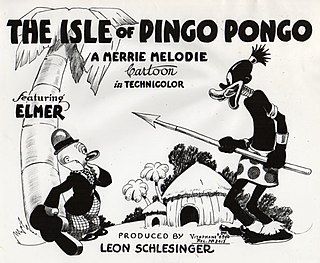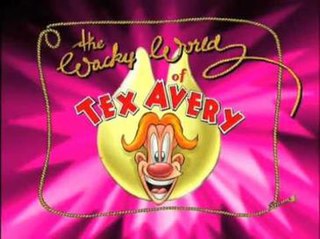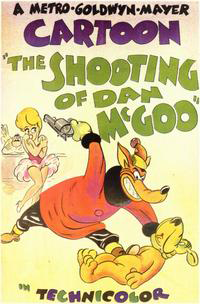Related Research Articles

Frederick Bean "Tex" Avery was an American animator, cartoonist, director, and voice actor. He was known for directing and producing animated cartoons during the golden age of American animation. His most significant work was for the Warner Bros. and Metro-Goldwyn-Mayer studios, where he was crucial in the creation and evolution of famous animated characters such as Bugs Bunny, Daffy Duck, Porky Pig, Elmer Fudd, Droopy, Screwy Squirrel, The Wolf, Red Hot Riding Hood, and George and Junior.

Robert Emerson Clampett Sr. was an American animator, director, producer and puppeteer. He was best known for his work on the Looney Tunes animated series from Warner Bros. as well as the television shows Time for Beany and Beany and Cecil. Clampett was born and raised not far from Hollywood and, early in his life, showed an interest in animation and puppetry. After leaving high school a few months shy of graduating in 1931, Clampett joined the team at Harman-Ising Productions and began working on the studio's newest short subjects, titled Looney Tunes and Merrie Melodies.

Red is an American animated character, created by Tex Avery, who appears in several MGM short films and Tom and Jerry films. She is a fictional nightclub singer and dancer who is usually making all men in the room crazy, especially a Wolf character who — in vain — tries to seduce and chase her. Red debuted in MGM's Red Hot Riding Hood, a modern-day variant of the fairy tale "Little Red Riding Hood".

Red Hot Riding Hood is an animated cartoon short subject, directed by Tex Avery and released with the movie Dr. Gillespie's Criminal Case on May 8, 1943 by Metro-Goldwyn-Mayer. In 1994, it was voted number 7 of The 50 Greatest Cartoons of all time by members of the animation field, making it the highest ranked MGM cartoon on the list. It is one of Avery's most popular cartoons, inspiring several of his own "sequel" shorts as well as influencing other cartoons and feature films for years afterward.

The Heckling Hare is a Merrie Melodies cartoon, released on July 5, 1941, and featuring Bugs Bunny and a dopey dog named Willoughby. The cartoon was directed by Tex Avery, written by Michael Maltese, animated by soon-to-be director Robert McKimson, and with musical direction by Carl W. Stalling. In a style that was becoming typical of the Bugs character, he easily outwitted and tormented his antagonist through the short, his only concern being what to do next to the dog.
Uncle Tom's Bungalow is an American Merrie Melodies animated cartoon directed by Tex Avery, and released to theatres on June 5, 1937 by Warner Bros. The short cartoon is a parody of the 1852 novel Uncle Tom's Cabin and of the "plantation melodrama" genre of the 1930s. It contains many stereotypical portrayals of black characters. The cartoon plays off Harriet Beecher Stowe's novel in that it portrays Uncle Tom as an old man, and wooden shacks and cotton fields pervade the scenery. Director Tex Avery adds his own sense of humor and "trickster" animation, giving the classic theme a modern, humorous twist.

The Isle of Pingo Pongo is a 1938 Merrie Melodies cartoon supervised by Tex Avery. The short was released on May 28, 1938 and features an early version of Elmer Fudd. This is the first of a series of travelogue spoofs, and the first Warner Bros. "spot gag" cartoon, where each vignette is punctuated by a moment of blackout.

The Tex Avery Show is an American animated showcase series of Metro-Goldwyn-Mayer and Warner Bros. cartoon shorts prominently by animator Tex Avery. In between the shorts, Don Kennedy gives short facts about the cartoons. The showcase premiered on the Cartoon Network in 1996, and was taken off the air in 2002, while reruns continued to be shown on Cartoon Network until June 2004. It was soon re-broadcast on Boomerang.

The Metro-Goldwyn-Mayer cartoon studio was the in-house division of Metro-Goldwyn-Mayer (MGM) during the Golden Age of American animation. Active from 1937 until 1957, the studio was responsible for producing animated shorts to accompany MGM feature films in Loew's Theaters, which included popular cartoon characters Tom and Jerry, Droopy and Barney Bear.

Blitz Wolf is a 1942 American animated propaganda short film produced and distributed by Metro-Goldwyn-Mayer. A parody of the Three Little Pigs told via a World War II perspective, the short was directed by Tex Avery and produced by Fred Quimby. It was nominated for the Academy Award for Best Short Subject: Cartoons but lost to Der Fuehrer's Face, another anti-Nazi World War II parody featuring Donald Duck.

The Wacky World of Tex Avery is an animated television series created by Robby London and co-produced by DIC Productions, L.P., Les Studios Tex SARL, Milimetros, M6 Métropole Télévision and Telcima.
The House of Tomorrow is a 1949 animated theatrical short directed by Tex Avery. It was part of a series of cartoons Avery did satirizing technology of the future which included: The Car of Tomorrow, The Farm of Tomorrow, and The T.V. of Tomorrow. These were satires of live action promotional films that were commonly shown in theaters at the time.

The Shooting of Dan McGoo is a cartoon directed by Tex Avery and starring Frank Graham as the Wolf. Both Bill Thompson and Avery himself voiced the lead character Droopy. Sara Berner did the speaking voice of Lou, while her singing was provided by Imogene Lynn. The cartoon was edited for a 1951 re-release. It is a loose remake of Avery's 1939 cartoon for Warners, Dangerous Dan McFoo.

Northwest Hounded Police is a 1946 American animated short film directed by Tex Avery, produced by Fred Quimby, and featuring Droopy and Avery's wolf character. A remake of Droopy's first cartoon Dumb-Hounded, the short revolves around the wolf on the run from Droopy, who is trailing the wolf in order to capture him. The title is a play on words on the film North West Mounted Police (1940).
The Farm of Tomorrow is a 1954 one-reel animated short subject directed by Tex Avery and produced by Fred Quimby. It was released theatrically with the feature filmmovie Rogue Cop on 18 September 1954 and distributed by Metro-Goldwyn-Mayer. The cartoon is one of Avery's future technology cartoons including The House of Tomorrow, The Car of Tomorrow and The TV of Tomorrow.

Uncle Tom's Cabaña is a 1947 American animated short film directed by Tex Avery. The short is a parody of Harriet Beecher Stowe's 1852 novel Uncle Tom's Cabin, and is Avery's second parody of the novel, the first being Uncle Tom's Bungalow in 1937 while at Warner Bros. Cartoons.
What's Buzzin' Buzzard? is a 1943 American animated short film directed by Tex Avery, produced by Fred Quimby, and musical score by Scott Bradley. The short pokes fun at the food shortages common at the time. The plot focuses on two turkey vultures struggling to find food in the desert. It was released to theaters on November 27, 1943 by Metro-Goldwyn-Mayer. Producer Fred Quimby disliked the cartoon but was surprised when it was put under the preservation in the Library of Congress. It is currently available on the Tex Avery Screwball Classics: Volume 1 Blu-Ray.
Cellbound is a 1955 cartoon short featuring Spike and directed by Tex Avery and Michael Lah. The story was by Heck Allen, and Paul Frees voiced all the characters.
Tex Avery Screwball Classics is a series of single-disc Blu-ray and DVD sets by Warner Bros. Home Entertainment's Warner Archive unit collecting various theatrical cartoons from animation director Tex Avery during his tenure at the Metro-Goldwyn-Mayer's cartoon division between the years of 1942 and 1955. It is the first comprehensive collection of Avery's MGM shorts to be released on home media in North America since The Compleat Tex Avery series of laserdiscs in the 1990s, with many of the shorts having been previously unreleased on DVD or Blu-ray.
Events in 1912 in animation.
References
- ↑ "AVERY…. Vol. 2??? WELL, IMAGINE THAT! -". cartoonresearch.com. 7 December 2020. Retrieved 15 December 2020.
- ↑ Lenburg, Jeff (1999). The Encyclopedia of Animated Cartoons. Checkmark Books. pp. 146–147. ISBN 0-8160-3831-7.